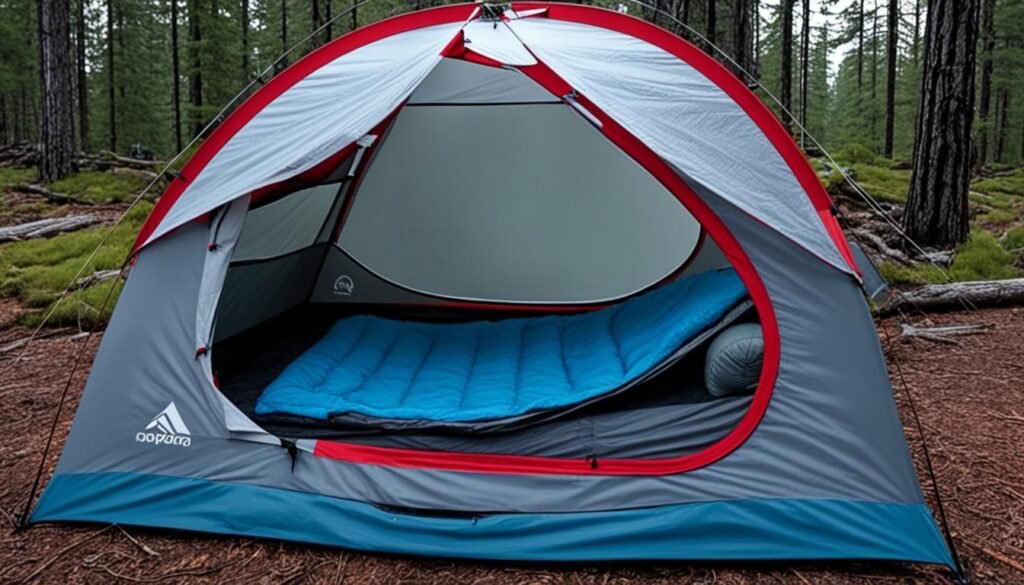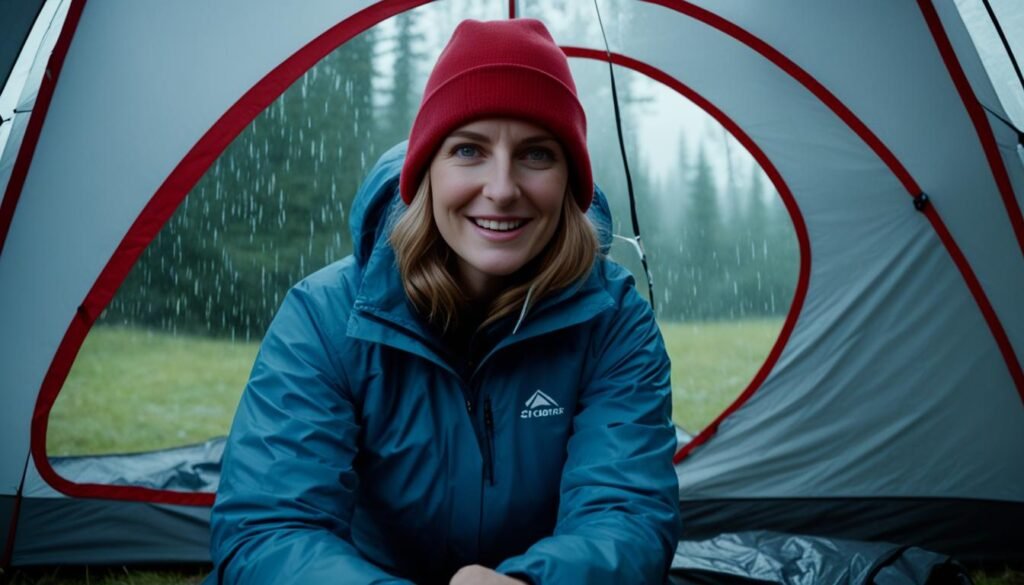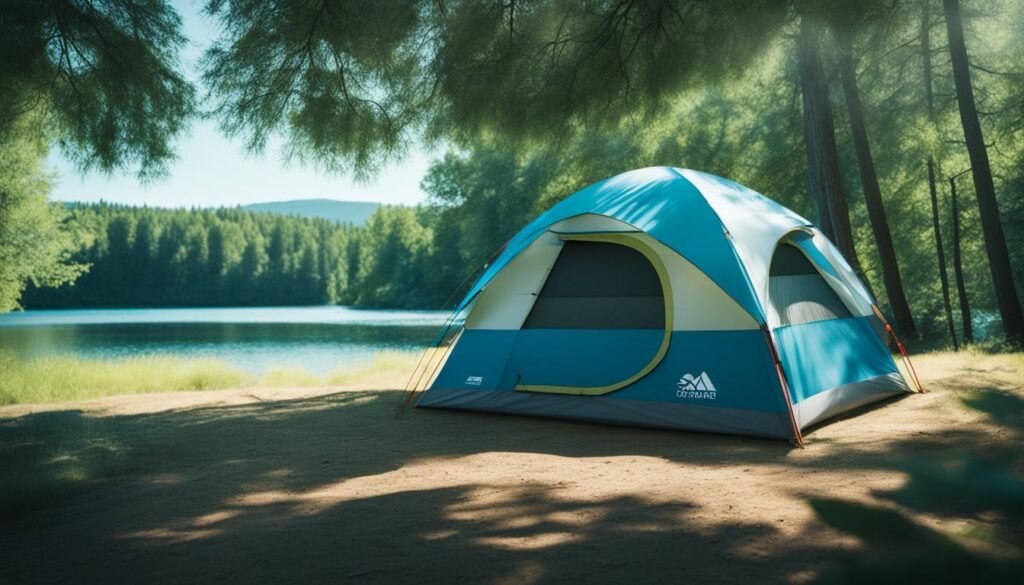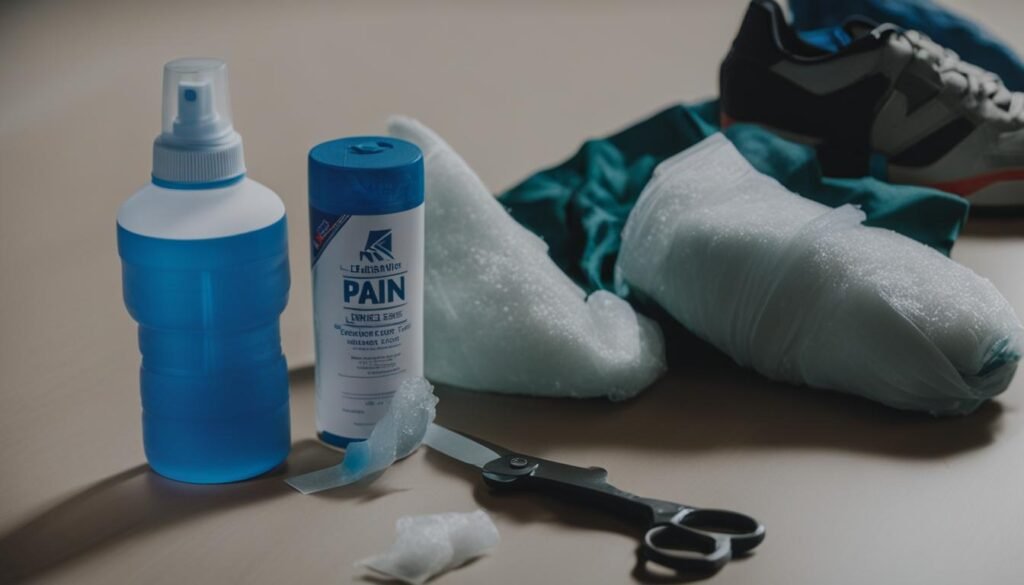Condensation can be a major issue when camping in a tent. It can make the interior of your tent damp and uncomfortable. However, there are several strategies you can use to prevent condensation and keep your tent dry.
Key Takeaways:
- Learn how to prevent condensation in your tent to ensure a dry and comfortable camping experience.
- Implement moisture control strategies to minimize condensation and dampness inside your tent.
- Maximize tent ventilation by choosing the right location, using proper tent ventilation techniques, and selecting a tent with good airflow.
- Consider using a rainfly or investing in innovative tent designs that help manage condensation.
- Take care of your tent by regularly cleaning, maintaining, and drying it after each use to prevent mold and mildew growth.
The Science behind Condensation
Condensation is a natural phenomenon that occurs when warm air comes into contact with a cold surface. This process can also happen inside a tent, leading to the formation of moisture and potentially damp conditions. Understanding the science behind condensation is crucial for effectively preventing it in your tent.
When you’re camping, the warm air inside the tent can come into contact with the cooler rainfly, which acts as the outer layer of your tent. As a result, the moisture in the air condenses on the underside of the rainfly, forming water droplets.
This condensation can be caused by various factors, including temperature differences inside and outside the tent, humidity levels, and inadequate ventilation. It’s important to note that condensation is more likely to occur in environments with high humidity or when there’s a significant difference in temperature between the air inside and outside the tent.
To visualize how condensation forms in a tent, imagine a cold glass of water on a warm day. As air with higher humidity comes into contact with the cold glass, the moisture in the air condenses on the glass surface, leading to droplets of water. The same principle applies to the condensation process inside your tent.
Now that we understand the science behind tent condensation, let’s explore effective strategies to prevent it and keep your tent dry and comfortable during your camping adventures.
Choosing the Right Location
One way to prevent condensation in your tent is to choose the right location to pitch it. The location where you set up your tent can greatly impact its susceptibility to condensation. By selecting an ideal tent pitching location, you can minimize the formation of condensation and ensure a dry and comfortable camping experience.
When picking a camping spot, prioritize finding a dry area on higher ground. Moisture tends to accumulate in low-lying areas, increasing the likelihood of condensation inside your tent. Choosing higher ground helps to avoid this issue and keeps your tent drier.
In addition to elevation, consider pitching your tent under trees. The air under tree cover is often warmer, which can help maintain a higher temperature inside your tent. This warmth prevents the rainfly, the outer layer of your tent, from becoming too cold and accumulating condensation. However, be mindful of any overhanging branches that may pose a safety risk.
Remember, the decision of where to pitch your tent plays a significant role in preventing condensation. Take some time to scout for an ideal location with these factors in mind, and you’ll be well on your way to a dry and comfortable camping experience.
| Key Considerations for Choosing the Right Location |
|---|
| Look for a dry spot on higher ground |
| Pitch your tent under trees for warmer air |
| Avoid low-lying areas prone to moisture accumulation |
Minimizing Moisture Sources
When it comes to preventing condensation in your tent, it’s essential to minimize the sources of moisture inside. Moisture can come from various sources, including the humidity in the air, your breath, and wet items brought into the tent.
To control moisture and reduce the likelihood of condensation, follow these tips:
- 1. Dry Wet Items Outside: Whenever possible, dry any wet items outside the tent before bringing them in. This includes wet clothing, towels, and gear. Removing excess moisture will help prevent it from accumulating inside the tent.
- 2. Avoid Bringing Wet Items Inside: If you have wet items that cannot be dried outside, consider keeping them in a separate area away from your sleeping area. This will help prevent moisture from spreading throughout the tent.
- 3. Use a Dehumidifier: If you’re camping in an area with high humidity, using a dehumidifier can help reduce moisture buildup inside the tent. A portable dehumidifier can effectively control the humidity levels and minimize condensation.
By controlling moisture sources and reducing the overall humidity inside the tent, you can significantly minimize the chance of condensation and keep your tent dry and comfortable.
Here’s a helpful overview of moisture sources and ways to minimize them:
| Moisture Source | Prevention Method |
|---|---|
| Humidity in the air | Use a dehumidifier or choose a camping location with lower humidity levels. |
| Your breath | Ensure proper ventilation by opening windows, doors, and vents. Consider using a tent with good airflow. |
| Wet items brought inside | Dry wet items outside the tent before bringing them in. Keep wet items separate from sleeping areas. |
Proper Ventilation Techniques
Proper ventilation is crucial for preventing condensation in your tent. By maximizing airflow and increasing air circulation, you can significantly reduce the chances of moisture buildup. Here are some tent ventilation tips to help you keep your tent dry and comfortable:
- Position your tent strategically: Face the door into a gentle breeze if possible. This will allow fresh air to enter and circulate throughout the tent.
- Stake your tent out tautly: Ensure that your tent is properly pitched and staked out. This will create maximum airspace inside the tent, allowing for better ventilation.
- Open all rainfly doors and windows: Opening the rainfly doors and windows will allow air to flow freely through the tent and prevent the buildup of humidity.
- Use all available vents: Many tents come with built-in vents that facilitate air circulation. Make sure to utilize these vents to maximize airflow.
By following these tent ventilation tips, you can effectively vent your tent and prevent condensation. Proper airflow will replace the humid interior air with drier outside air, minimizing the chances of condensation forming inside your tent.
Comparing Ventilation Techniques
| Ventilation Technique | Benefits |
|---|---|
| Pitching tent strategically | Allows fresh air to enter and circulate inside the tent |
| Staking tent tautly | Creates maximum airspace for better ventilation |
| Opening all rainfly doors and windows | Allows air to flow freely through the tent |
| Using all available vents | Enhances cross ventilation and improves air circulation |
Using a Rainfly
A rainfly is a vital accessory for campers looking to protect their tent from the elements. This separate cover goes over your tent, providing an additional layer of protection against rain, wind, and snow. However, the benefits of a rainfly extend beyond weatherproofing. By using a rainfly, you can also prevent condensation from forming inside your tent, ensuring a dry and comfortable camping experience.
When warm air inside your tent comes into contact with the cooler rainfly, condensation can occur. This moisture buildup can make the interior of your tent damp and uncomfortable. However, by using a rainfly, you create an extra barrier between the warm interior of your tent and the cooler outside air, reducing the chances of condensation.
Not only does a rainfly help prevent condensation, but it also keeps the top of your tent clean and dry. By covering the tent, a rainfly provides an additional layer of protection against dirt, debris, and tree sap. This means less cleaning and maintenance for you, ensuring that your tent stays in good condition for years to come.
Choosing a Tent with Good Ventilation
When it comes to selecting the right tent, ventilation is a crucial factor to consider in order to prevent condensation. A tent with good airflow can make a significant difference in keeping the interior dry and comfortable. Here are some features to look for when choosing a ventilated tent:
- Large doors with mesh panels: Opt for tents that have large doors with integrated mesh panels. These panels allow for proper airflow while keeping bugs and insects out.
- Windows for adjustable airflow: Look for tents that have windows that can be rolled down to control the amount of airflow. This allows you to customize the ventilation based on the weather conditions.
- Ceiling ventilation points: Some tents come with ceiling ventilation points or vents. These strategically placed openings allow hot air to escape and fresh air to circulate, minimizing condensation buildup.
Choosing a tent with these ventilation features ensures better air circulation inside the tent, reducing the chances of condensation. By allowing fresh air to flow in and warm, moist air to escape, you can create a more comfortable camping experience.

Having a tent with good ventilation is essential for a condensation-free camping trip. Not only does it help prevent moisture buildup, but it also enhances overall comfort. Remember to look for tents with large mesh doors, adjustable windows, and ceiling ventilation points to maximize airflow.
“Choosing a tent with good ventilation is the first step in preventing condensation and ensuring a comfortable camping experience.”
Tips for Bell Tents
Bell tents, with their high peaks and spacious interiors, are particularly prone to condensation. To prevent condensation in a bell tent, there are a few key tips to keep in mind.
Pitching the Tent Correctly
When setting up your bell tent, it’s important to ensure it is pitched correctly to optimize ventilation and airflow. Position the door of the tent to face the wind direction, which will help promote air circulation and prevent condensation buildup. This strategic positioning allows fresh air to enter the tent and push out any humid air, reducing the risk of condensation.
Consider Using a Rainfly
A rainfly is a protective cover that can be placed over the top of your bell tent. It serves as an additional barrier between the warm interior of the tent and the cooler outside air, helping to prevent condensation. A rainfly can also help keep the top of your tent clean and dry, further reducing the likelihood of condensation.
Keep Windows Cracked Open
Proper ventilation is key to managing condensation in a bell tent. Keep the windows of your tent cracked open, even if it’s just a small amount. This allows for airflow and helps to circulate fresh air, minimizing the buildup of moisture inside the tent. Be mindful of weather conditions and safely adjust the window openings accordingly.
Implementing these tips will help you manage condensation in your bell tent and ensure a comfortable camping experience.
Introducing Innovative Tent Designs
As camping technology continues to evolve, tent manufacturers are introducing innovative designs that address the issue of condensation. These new tent designs feature advanced ventilation technology and innovative features to effectively manage condensation and keep your tent dry.
Tension Ridges for Enhanced Ventilation
One of the key features in these innovative tent designs is the incorporation of tension ridges. These ridges help create a larger air gap between the rainfly and the inner tent, allowing for better airflow and ventilation. As warm air rises in the tent, it can escape through the tension ridges, reducing the chances of condensation buildup.
Higher and Wider Doors for Improved Airflow
Another feature to look out for in these tents is the inclusion of higher and wider doors. These larger door openings allow for increased airflow and better ventilation throughout the tent. With more fresh air entering the tent, the chances of condensation forming are significantly reduced, ensuring a drier and more comfortable camping experience.
Vertical Walls for Condensation Prevention
Innovative tent designs also incorporate vertical walls to prevent contact with condensation. By utilizing vertical walls, the tent’s inner walls are less likely to come in contact with the rainfly, reducing the transfer of moisture and minimizing the chances of condensation buildup inside the tent.
Investing in a tent with these advanced features will greatly minimize condensation and provide you with a dry and comfortable camping experience. With improved ventilation and condensation management, these innovative tent designs are revolutionizing the camping industry.
Don’t compromise on your camping comfort. Choose a tent with innovative features and enjoy the great outdoors without the hassle of condensation.
Packing Up a Wet Tent
If your tent becomes wet due to condensation or rain, it’s important to take the necessary steps to dry it properly before packing it up. Not only will this help prevent the growth of mold and mildew, but it will also ensure that your tent stays in good condition for future use.
- Separate the rainfly from the inner tent: Often, the rainfly bears the brunt of the moisture, so it’s crucial to remove it from the inner tent. This will prevent any residual moisture from transferring to the rest of the tent during storage.
- Wipe down the tent: Use a clean towel or cloth to wipe down the interior and exterior of the tent, focusing on areas where moisture may have collected. This will help remove excess moisture and speed up the drying process.
- Allow the tent to dry in the sun: Find a sunny and well-ventilated area to set up the tent. Ensure that it is fully stretched out and secured properly. The warmth of the sun will aid in evaporating any remaining moisture.
To prevent mold and mildew growth, it’s essential to ensure that the tent is completely dry before packing it up. This may take several hours or even a full day, depending on the weather conditions. Once dry, fold the tent neatly and pack it in a breathable storage bag or container to prevent any moisture buildup.

By following these proper drying techniques, you can avoid mold and mildew issues and extend the lifespan of your tent. Taking the time to dry your tent thoroughly will ensure that it’s ready for your next camping adventure.
Camping Tips for Wet Conditions
When camping in wet conditions, it’s important to take extra precautions to stay dry and comfortable in your tent. Wet weather can increase the chances of condensation, making the interior of your tent damp and unpleasant. Follow these camping tips to minimize condensation and ensure a dry camping experience.
Choose a Tent with Good Waterproofing
One of the most important factors in staying dry during wet camping is choosing a tent with good waterproofing. Look for tents that have a high waterproof rating and fully taped seams to keep rainwater out. Additionally, consider investing in a tent with a bathtub-style floor to prevent water from seeping in from the ground.
Set Up in a Sheltered Location
When selecting a camping spot, try to find a location that offers some natural protection from the rain. Look for areas with trees or natural windbreaks that can provide additional shelter. Setting up your tent in a sheltered spot can help reduce the impact of rain and minimize the chances of water pooling around your tent.
Use a Rainfly and Groundsheet
A rainfly is an essential piece of gear for camping in wet conditions. It provides an extra layer of protection against rain and helps prevent water from coming into contact with your tent. Make sure to properly secure your rainfly to ensure it stays in place during windy conditions.
Additionally, using a groundsheet or footprint underneath your tent can help protect the bottom of your tent from moisture seeping in from the ground. It adds an extra barrier between your tent and the wet ground, keeping you dry and comfortable.
Consider Using a Tent Heater or Insulation
If you’re camping in extremely wet and cold conditions, using a tent heater or insulation can help keep the interior warm and reduce condensation. Be sure to follow the manufacturer’s instructions and take proper safety precautions when using a tent heater.
“Camping in wet conditions can be challenging, but with the right preparations, you can still enjoy your outdoor adventure. Choosing a tent with good waterproofing, setting up in a sheltered location, using a rainfly and groundsheet, and considering additional heat sources will help keep you dry and comfortable.”
By following these camping tips, you can minimize condensation and stay dry in a rainy tent. Remember to check the weather forecast before your camping trip and pack appropriate gear to protect yourself and your equipment from the rain. Happy camping!
Regular Cleaning and Maintenance
Regular cleaning and maintenance are essential for keeping your tent in good condition and preventing condensation. By following these simple steps, you can prolong the lifespan of your tent and ensure a comfortable camping experience.
After each use, take the time to clean your tent. Start by removing any dirt or debris from the exterior and interior. Use a soft brush or sponge and mild soap to gently scrub away stubborn stains or grime. Rinse thoroughly with clean water and allow the tent to dry completely before packing it away.
TIP: Make sure to read and follow the manufacturer’s instructions for cleaning your specific tent model.
Inspect for Mold and Mildew
Regularly inspect your tent for signs of mold and mildew. These fungal growths thrive in damp environments and can cause health issues and damage to your tent. Look for any discoloration or musty odors, particularly in areas where moisture tends to accumulate.
If you find any mold or mildew, it’s crucial to address it promptly. Mix a solution of equal parts water and white vinegar and use a soft cloth or sponge to gently wipe down the affected areas. Allow the tent to dry thoroughly in a well-ventilated area, preferably under the sun, before storing it.
Check for Damage and Leaks
Regularly check your tent for any signs of damage or leaks. Inspect the seams, zippers, and fabric for any tears, holes, or wear. Repair any small damages immediately using a tent repair kit or patch. For more substantial damage, such as broken poles or significant tears, consult the manufacturer or a professional for proper repair.
It’s also important to inspect the waterproofing capabilities of your tent. Over time, the waterproof coating on the fabric may wear off. If you notice that water droplets are not beading up and rolling off the surface, it may be time to reapply a waterproof treatment or seam sealer.
Proper Storage
When not in use, store your tent in a cool, dry place. Avoid storing it in areas prone to high humidity or extreme temperatures, as these conditions can promote mold growth and damage the fabric. Make sure the tent is completely dry before packing it away to prevent the growth of mold or mildew during storage.
TIP: To keep your tent organized and easily accessible, consider using a storage bag or container specifically designed for camping gear.
By regularly cleaning and maintaining your tent, you can prevent condensation, prolong its lifespan, and ensure a comfortable camping experience. Taking the time to inspect for mold, mildew, damage, and leaks will help you address any issues promptly and keep your tent in excellent condition for many camping trips to come.
Conclusion
Preventing condensation in your tent is essential for a comfortable and enjoyable camping experience. By following these tips, you can minimize moisture buildup and keep your tent dry inside. Start by choosing the right location and pitch your tent on higher ground, preferably under trees. This will help keep your rainfly warmer and prevent condensation from forming.
Additionally, minimize moisture sources inside your tent by drying wet items outside and using a dehumidifier to reduce humidity. Proper ventilation is crucial, so ensure that your tent is pitched with maximum airflow in mind. Open all rainfly doors and windows, and use all available vents for cross ventilation.
Consider using a rainfly and investing in a tent with good ventilation features to further prevent condensation. Lastly, regular cleaning and maintenance will help prolong the life of your tent and minimize the chances of condensation. By following these strategies, you can keep your tent dry and enjoy your camping adventures without the hassle of condensation.
FAQ
How can I prevent condensation in my tent?
To prevent condensation in your tent, choose the right location to pitch it, minimize moisture sources, ensure proper ventilation, use a rainfly, consider a tent with good ventilation features, and pack up a wet tent correctly.
Why does condensation occur in tents?
Condensation occurs in tents when warm air inside the tent comes into contact with the cooler rainfly. The moisture in the air then condenses on the underside of the rainfly, leading to a buildup of water droplets.
How does choosing the right location help prevent condensation in a tent?
Choosing the right location, such as a dry spot on higher ground and under trees, can help prevent condensation. Air under trees tends to be warmer, which keeps the rainfly warmer and reduces condensation.
What are some ways to minimize moisture sources in a tent?
To minimize moisture sources, dry wet items outside the tent, avoid bringing them inside, and consider using a dehumidifier to reduce overall humidity inside the tent.
How can I ensure proper ventilation in my tent?
Ensure proper ventilation by pitching the tent with maximum airflow in mind, facing the door into a gentle breeze, staking the tent tautly to maximize airspace, opening all rainfly doors and windows, and using available vents for cross ventilation.
Can using a rainfly help prevent condensation in a tent?
Yes, using a rainfly can help prevent condensation by creating an extra barrier between the warm interior of the tent and the cooler outside air. It also helps keep the top of the tent dry and reduces the likelihood of condensation.
What should I look for when choosing a tent with good ventilation?
Look for a tent with features like large doors with mesh panels, windows that can be rolled down for airflow, and ceiling ventilation points. These features allow for better air circulation inside the tent and reduce condensation.
How can I prevent condensation in a bell tent?
To prevent condensation in a bell tent, pitch it correctly with the door facing the wind for optimal airflow, consider using a rainfly, and keep the windows cracked open for ventilation.
Are there tents with innovative designs that can help manage condensation?
Yes, several tent manufacturers have introduced innovative designs that help manage condensation. These designs include features like tension ridges for better ventilation, higher and wider doors for increased airflow, and vertical walls to prevent contact with condensation.
How should I pack up a wet tent to prevent mold and mildew?
To pack up a wet tent, separate the rainfly from the inner tent and pack them separately. Wipe down the tent with a towel to remove excess moisture and allow it to dry in the sun. This prevents mold and mildew growth and helps keep the tent in good condition.
What are some camping tips for wet conditions to prevent condensation in a tent?
To stay dry in wet conditions, choose a tent with good waterproofing, set up in a sheltered location, use a rainfly and groundsheet for added protection, and consider using a tent heater or insulation to keep the interior warm and reduce condensation.
How can regular cleaning and maintenance help prevent condensation in a tent?
Regular cleaning and maintenance of the tent can help prevent condensation and prolong its lifespan. Clean the tent after each use, store it in a dry place, inspect for mold or mildew, and check for damage or leaks to repair them promptly.







